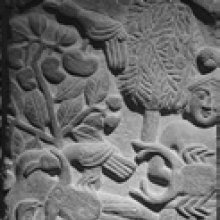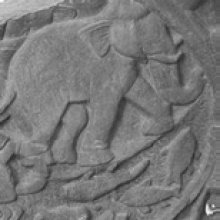Kakkata Jataka, Kakkata-jātaka: 1 definition
Introduction:
Kakkata Jataka means something in Buddhism, Pali. If you want to know the exact meaning, history, etymology or English translation of this term then check out the descriptions on this page. Add your comment or reference to a book if you want to contribute to this summary article.
Images (photo gallery)
In Buddhism
Theravada (major branch of Buddhism)
Source: Pali Kanon: Pali Proper NamesOnce a golden crab as large as a threshing floor lived in Kuliradaha in the Himalaya, catching and eating the elephants who went into the lake to drink. In terror they left the district. The Bodhisatta, being born among the elephants, took leave of his father, and went back into the lake with his friends. The Bodhisatta, being the last to leave the water, was caught by the crabs claws; hearing his cries of pain, all the other elephants ran away except his mate, whom he entreated not to leave him.
Realizing her duty, the she elephant spoke to the crab words of coaxing and of flattery; the crab, fascinated by the sound of a female voice, let go his hold. Whereupon the Bodhisatta trampled him to death. From the two claws of the crab were later made the Anaka and the Alambara drums (q.v.).
The story was related in reference to the wife of a landowner of Savatthi. Husband and wife were on their way to collect some debts when they were waylaid by robbers. The robber chief, wishing to possess the wife for her beauty, planned to kill the husband. The wife expressed her determination to commit suicide if her husband were killed, and they were both released. The she elephant of the Jataka was the landowners wife (J.ii.341-5).
This Jataka is illustrated in the Barhut Stupa (Cunningham; Bharhut plate xxv.2).
The Kakkata Jataka is mentioned (DhA.i.119) among those preached by the Buddha giving instances where Ananda offered his life for that of the Bodhisatta. The reference is evidently to the Suvannakakkata Jataka (q.v.).
The story is also found in the Samyutta Commentary (SA.ii.167), but there the Bodhisattas life is saved not by his mate but by his mother.
Theravāda is a major branch of Buddhism having the the Pali canon (tipitaka) as their canonical literature, which includes the vinaya-pitaka (monastic rules), the sutta-pitaka (Buddhist sermons) and the abhidhamma-pitaka (philosophy and psychology).
See also (Relevant definitions)
Partial matches: Kakkata, Jataka.
Ends with: Suvannakakkata Jataka.
Relevant text
No search results for Kakkata Jataka, Kakkata-jātaka; (plurals include: Kakkata Jatakas, jātakas) in any book or story.

